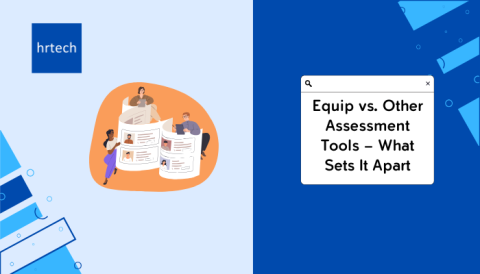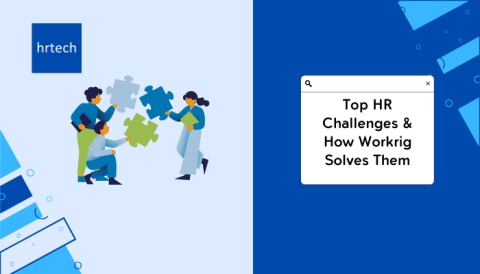Human Resource Information Systems (HRIS) are indispensable for streamlining HR operations, improving efficiency, and enabling data-driven decisions. With the right HR software, organisations can achieve better workforce management and align HR strategies with business goals.
In this article, we’ll explore the key phases of HRIS assessment and selection, supplemented by a list of the top HR software for HR management.
What is HRIS?
A Human Resource Information System (HRIS) is a software solution designed to manage, streamline, and optimise human resource operations within an organisation. By integrating core HR functions into a centralised platform, HRIS enables businesses to improve efficiency, accuracy, and decision-making in managing their workforce.
Key Features of HRIS
1. Employee Data Management:
- Stores and organises employee records, including personal details, job history, and performance reviews.
- Ensures compliance with data protection regulations.
2. Payroll and Benefits Administration:
- Automates salary calculations, tax deductions, and benefits tracking.
- Integrates with financial systems for seamless payroll processing.
3. Recruitment and Onboarding:
- Simplifies job posting, applicant tracking, and new hire onboarding processes.
- Reduces time-to-hire and enhances the candidate experience.
4. Time and Attendance Tracking:
- Monitors employee working hours, leave requests, and overtime.
- Provides real-time insights into workforce availability.
5. Performance Management:
- Tracks employee goals, reviews, and feedback.
- Supports succession planning and career development initiatives.
6. Compliance and Reporting:
- Generates reports on HR metrics, such as turnover rates and workforce demographics.
- Helps organisations adhere to labor laws and regulatory requirements.
Types of HRIS Systems
- On-Premise HRIS: Installed and maintained on the organisation’s servers. Suitable for companies with strict data security requirements.
- Cloud-Based HRIS: Hosted on the cloud, offering flexibility, scalability, and remote access. Ideal for businesses of all sizes.
- Hybrid HRIS: Combines features of both on-premise and cloud-based systems, offering a balance of control and convenience.
Ready to transform your HR operations with an HRIS? Let HRTech help you find the right solution. Contact us today for expert guidance and insights!
Critical Importance of HRIS Needs Analysis
An HRIS needs analysis is the backbone of a successful HR technology strategy. By systematically identifying an organisation’s specific HR challenges and goals, a needs analysis ensures that the selected HRIS aligns with current and future business objectives.
Here’s why conducting an HRIS needs analysis is essential:
1. Align technology with Business Goals
- An effective needs analysis ensures that the HRIS supports strategic objectives, such as improving employee engagement, streamlining recruitment, or enhancing compliance.
- Organisations with HRIS systems aligned to their goals experience up to 60% greater efficiency in HR operations.
2. Identifies Pain Points and Process Gaps
- Pinpoints inefficiencies in current HR processes, such as manual data entry, lack of integration, or delayed payroll processing.
- Helps address bottlenecks that cost businesses time and money.
3. Ensures Stakeholder Alignment
- Brings HR, IT, finance, and management onto the same page regarding system requirements.
- Reduces the risk of conflicting priorities during implementation.
4. Prevents Overinvestment or Underutilization
- Avoids the purchase of overly complex systems with unnecessary features or underpowered solutions that fail to meet core requirements.
- Saves costs by focusing on features that directly address organisational needs.
5. Anticipates Future Needs
- Accounts for projected organisational growth, evolving workforce dynamics, and emerging HR trends.
- Ensures scalability to avoid frequent system overhauls.
6. Facilitates Vendor Evaluation
- Provides a clear benchmark for assessing HRIS options during demos and vendor negotiations.
- Makes it easier to compare features, functionality, and costs against predefined requirements.
7. Improves Implementation Success Rates
- A needs-driven approach minimizes missteps during implementation by ensuring the chosen system integrates seamlessly with existing processes.
- Organisations that perform needs analysis have a 30% higher chance of meeting project deadlines.
By conducting a comprehensive HRIS needs analysis, organisations can select a solution that not only meets immediate needs but also positions them for long-term success.
After understanding HRIS needs, the next step is translating these insights into a solid implementation strategy. Let’s explore the phases of HRIS implementation.
Phases of HRIS Implementation
The successful implementation of an HRIS begins with understanding the unique challenges and objectives of your organisation. Diagnosing HR pain points reveals inefficiencies in current processes, while aligning the system with growth goals ensures a future-ready solution. These foundational steps pave the way for selecting the right HR software tailored to your needs.
1. Diagnosing HR Pain Points and Conditions
- Identify inefficiencies in current HR operations, such as manual processes or compliance risks.
- Use surveys or feedback tools to pinpoint areas of employee dissatisfaction with existing systems.
2. Key Considerations in Aligning HRIS with Growth Objectives
- Ensure the HRIS supports scalability, adaptability, and integration with other business tools.
- Prioritise systems with automation capabilities to reduce administrative workloads.
Once the groundwork is laid, the next step is identifying your organisational requirements to understand which software would suit you the best.
Organisational Requirements and HRIS
Implementing an HRIS requires aligning the system with your organization’s operational needs and long-term goals. By understanding current challenges, gathering stakeholder input, and planning for future growth, you can ensure the HRIS delivers maximum value.
1. Supporting Business Operations:
- Through HRIS Centralized systems boost compliance, analytics, and employee self-service.
- Case studies show companies can reduce administrative time by 20%-30% using HRIS.
2. Gathering Requirements from Multiple Stakeholders:
- Conduct interviews or surveys with HR leaders, department managers, and employees.
- Document pain points and wishlist features, prioritizing common themes.
3. Anticipating Future Organisational Needs:
- Factor in scalability for future growth or market expansion.
- Evaluate trends in HR tech, such as AI-powered analytics and mobile accessibility.
With a solid understanding of how HRIS supports organisational needs, let’s now explore the top HR software solutions available to enhance HR management.
Top 10 Software for HR Management
The right HR software can transform HR operations by automating processes, improving compliance, and enhancing employee engagement.
1. Oracle Human Capital Management
Oracle HCM is a comprehensive HR solution ideal for large enterprises with global teams. It integrates HR functions with business objectives, making it perfect for companies that need a scalable and data-driven approach to manage their workforce.
Key features:
- Advanced Analytics: Leverage data insights for better decision-making in talent acquisition, retention, and organisational growth.
- Talent Management: Streamline recruitment, onboarding, and performance management with integrated tools.
- Workforce Planning: Optimise workforce allocation with real-time data and predictive analytics.
- Global Scalability: A robust platform that supports multinational operations, ensuring seamless HR management across various locations.
Oracle HCM integrates HR functions with business goals, providing a unified platform to enhance talent acquisition, retention, and organisational growth.
2. ADP
ADP is a trusted name in payroll and compliance tools, offering a scalable solution for organisations of all sizes, particularly those with complex payroll and tax compliance needs.
Key Features:
- Payroll Automation: Automate payroll processing to ensure timely and accurate employee payments across multiple jurisdictions.
- Tax Compliance: Ensure your business stays compliant with local and international tax laws.
- Employee Benefits Management: Simplify benefits administration and enrollment, making it easier for employees to manage their perks.
- Time Tracking: Track work hours, manage attendance, and streamline payroll calculations with integrated time-tracking features.
ADP excels in managing payroll complexities and maintaining compliance across various jurisdictions, making it a top choice for multinational companies.
3. 247HRM
Designed for small to medium-sized businesses, 247HRM is a cost-effective and easy-to-use HR software that simplifies HR tasks like employee management and payroll processing.
Key Features:
- Employee Database Management: Centralize all employee records for quick access and efficient management.
- Attendance Tracking: Easily monitor employee attendance, shifts, and time-off requests.
- Payroll Processing: Automate payroll, tax deductions, and salary generation, reducing administrative overhead.
- Reporting: Generate insightful reports on employee performance, attendance, and payroll data.
247HRM is designed for businesses that need an efficient yet scalable HR solution without the complexities of larger systems.
4. BambooHR
BambooHR is known for its user-friendly interface and focus on employee experience. Ideal for startups and mid-sized companies, it enhances HR operations through a variety of employee engagement and management tools.
Key Features:
- Employee Self-Service Portals: Allow employees to manage their own information, benefits, and time-off requests.
- Performance Management: Monitor and improve employee performance with feedback, goal setting, and review systems.
- Onboarding Tools: Simplify the recruitment and onboarding process, making it easier to bring new hires up to speed quickly.
- Payroll Integration: Integrate payroll systems to streamline compensation processes seamlessly.
BambooHR’s intuitive interface and employee-centric tools make it an ideal choice for organisations looking to foster a positive workplace culture.
5. Enfinity
Enfinity is a highly customizable HR solution that can adapt to an organization’s unique operational needs. It is best suited for companies requiring tailored HR software that integrates payroll, employee management, and compliance tracking.
Key Features:
- Custom Workflows: Create personalised workflows that align with your company’s processes and policies.
- Employee Lifecycle Management: Manage everything from hiring to retirement with a fully integrated HR solution.
- Payroll and Tax Compliance: Automate payroll processes and ensure tax compliance with up-to-date labor laws.
- Compliance Tracking: Monitor regulatory changes and ensure your HR practices remain compliant with minimal effort.
Enfinity’s flexibility allows businesses to design an HR solution that aligns perfectly with their internal processes and compliance needs.
6. BIPO
An all-in-one HR solution with localised support for multinational companies, BIPO offers tailored HR services to meet diverse regulatory requirements and HR needs across borders.
Key Features:
- Global Payroll Processing: Handle payroll across multiple countries with full compliance to local labor laws and regulations.
- Employee Data Management: Centralise employee data for easy access and management across regions.
- HR Analytics: Use data-driven insights to improve HR strategies and enhance workforce performance.
- Compliance with Local Labor Laws: Ensure your company remains compliant with varying labour laws across multiple regions, reducing legal risks.
BIPO’s localised HR support ensures compliance and smooth HR operations across multiple regions, ideal for organisations with a global presence.
7. ZingHR
ZingHR is a cloud-based HR solution that leverages AI-powered insights to manage the entire employee lifecycle, making it ideal for fast-growing businesses looking for scalable HR tools.
Key Features:
- AI-Driven Analytics: Use AI to gain predictive insights into workforce trends, performance, and engagement.
- Employee Engagement Tools: Boost employee satisfaction with tools that promote communication, feedback, and recognition.
- Time Tracking: Track work hours and manage attendance more efficiently using AI-enhanced features.
- Performance Management: Set goals, review performance, and offer constructive feedback to employees in real time.
ZingHR leverages cutting-edge AI technology to offer predictive analytics and actionable insights that improve decision-making and HR processes.
8. Unit4
Unit4 is specifically designed for service industries like education, healthcare, and public services. Its focus is on workforce planning, payroll, and expense management, making it ideal for service-oriented businesses.
Key Features:
- Employee Scheduling: Easily schedule and manage employee shifts, ensuring optimal coverage for service roles.
- Payroll Processing: Automate payroll calculations, including overtime, bonuses, and deductions.
- Expense Reporting: Streamline the submission and approval of employee expenses for efficient reimbursement processes.
- Workforce Management: Manage staffing levels and optimise resource allocation with tools tailored to service-based industries.
Unit4 is an industry-specific solution, providing tools optimised for the unique needs of service-oriented businesses.
9. Swingvy
Swingvy is a simplified HR platform designed for small and medium-sized enterprises (SMEs). It offers core HR functions like payroll, benefits administration, and tax compliance, all in one platform.
Key Features:
- Payroll Automation: Process payroll quickly and accurately, with tax deductions and statutory compliance built-in.
- Employee Data Management: Store and manage employee data in one secure location, accessible to both HR managers and employees.
- Benefits Administration: Administer employee benefits, including insurance and retirement plans, without manual intervention.
- Tax Compliance: Stay compliant with local tax regulations, automatically calculating deductions and generating reports.
Swingvy’s simplicity and affordability make it an attractive option for smaller teams seeking streamlined HR operations without the complexity of larger platforms.
10. JustLogin
A straightforward HR platform, JustLogin focuses on payroll management, leave tracking, and time attendance with the added bonus of mobile accessibility for employees.
Key Features:
- Payroll Management: Automate payroll calculations and ensure accuracy in salary payments, tax deductions, and statutory compliance.
- Leave Management: Simplify leave requests, approvals, and tracking to ensure smooth workforce management.
- Time Tracking: Track employee attendance, work hours, and overtime efficiently with real-time reporting.
- Mobile Access: Provide employees with access to HR functions on-the-go via a mobile app for added convenience.
JustLogin offers a simple yet effective HR platform for small businesses looking for essential HR functions without added complexity.
Selecting the right HR software depends on your organisation’s size, industry, and unique needs. Now that we’ve covered the top 10 HR software options, it’s time to choose the one that best fits your organisational goals.
Conducting a Thorough HRIS Needs Analysis
A successful HRIS implementation begins with a comprehensive needs assessment. By systematically evaluating your HR department’s specific needs, you can identify gaps in current processes, improve operational efficiency, and ensure compliance with industry standards.
- A systematic approach to identifying the specific functionalities your HR department requires to enhance productivity and compliance.
- HRIS assessments focus on HR-specific needs, such as payroll, compliance, and performance tracking, which are often overlooked in general software evaluations.
- The pre-assessment strategies include:
- Engage key stakeholders to understand their requirements.
- Audit current systems and processes to identify gaps.
Let’s explore the key aspects of HRIS needs analysis, from understanding its purpose to using it for vendor selection, laying the foundation for informed, long-term decisions.
Key Factors in HRIS Selection
An HRIS needs assessment is invaluable when narrowing down vendors and evaluating potential solutions. It provides a clear framework for aligning vendor capabilities with your organization’s specific requirements, ensuring you choose a system that delivers real value.
1. Features and Functionality Considerations:
- Look for customizable workflows, advanced reporting, and integration capabilities.
- Ensure compliance features meet local and global regulations, particularly in highly regulated industries.
2. Cost Considerations in HRIS Selection:
- Compare upfront costs, subscription fees, and potential ROI.
- The average cost of HRIS implementation can range from $100,000 to $300,000, depending on the organization’s size and complexity.
3. The Importance of Configurability and Intuitiveness:
- Systems should require minimal training and support personalized workflows.
4. Forming an Experienced Selection Team:
- Include members with expertise in HR, IT, and finance.
- Assign a project manager to ensure timelines and goals are met.
Now, let’s explore how to use your needs assessment to guide vendor demos, develop tailored scenarios, and ask the right questions to find the perfect HRIS for your organization.
Using HRIS Needs Analysis in Vendor Selection
Leveraging your HRIS needs analysis during vendor selection ensures you focus on solutions that address your organization’s critical pain points. It allows for a structured evaluation process, making it easier to identify the best-fit system.
1. Guiding Demos and Evaluating Vendors: Use needs assessment findings to create targeted demo requests. Assess vendors on their ability to meet key requirements.
2. Developing Scenarios Based on Critical Requirements: Present vendors with hypothetical challenges (e.g., handling seasonal workforce surges).
3. Essential Questions to Ask Potential Vendors: What is the average implementation timeline? How do you handle data migration and integration? What ongoing support and updates do you provide?
With your assessment as a guide, let’s explore how to structure demos, create realistic scenarios, and ask essential questions to select the most suitable HRIS.
Next Steps after Selection
A thorough HRIS needs analysis simplifies vendor selection by identifying solutions that align with your organization’s goals and challenges. It ensures you focus on vendors that address both current requirements and future growth needs.
- Use vendor insights and internal goals to finalise the project timeline.
- Examples include: achieving 90% employee adoption within three months or reducing onboarding time by 50%.
- Regularly review system performance and align it with evolving organizational needs.
Conclusion
Implementing an HRIS is more than just a technological upgrade, it’s a strategic move toward enhancing workforce efficiency and achieving business goals. A dynamic and ongoing assessment ensures the system continues to meet organizational needs, driving HR’s role as a strategic partner.
Looking for expert guidance on HRIS implementation? HRTech offers tailored solutions to help you navigate the complexities of HR technology. Contact us today for a consultation or explore our resources to stay ahead in the ever-evolving HR landscape.





